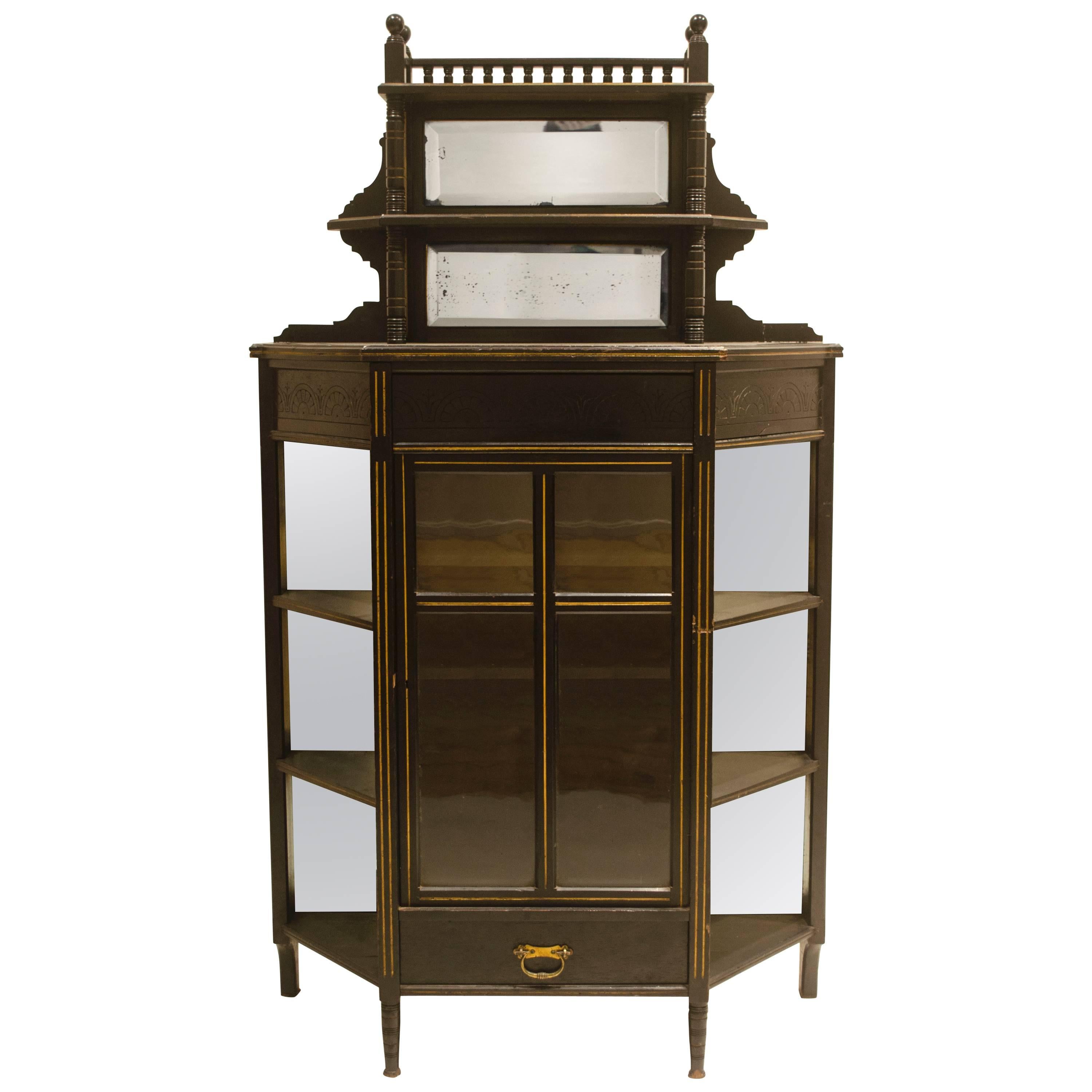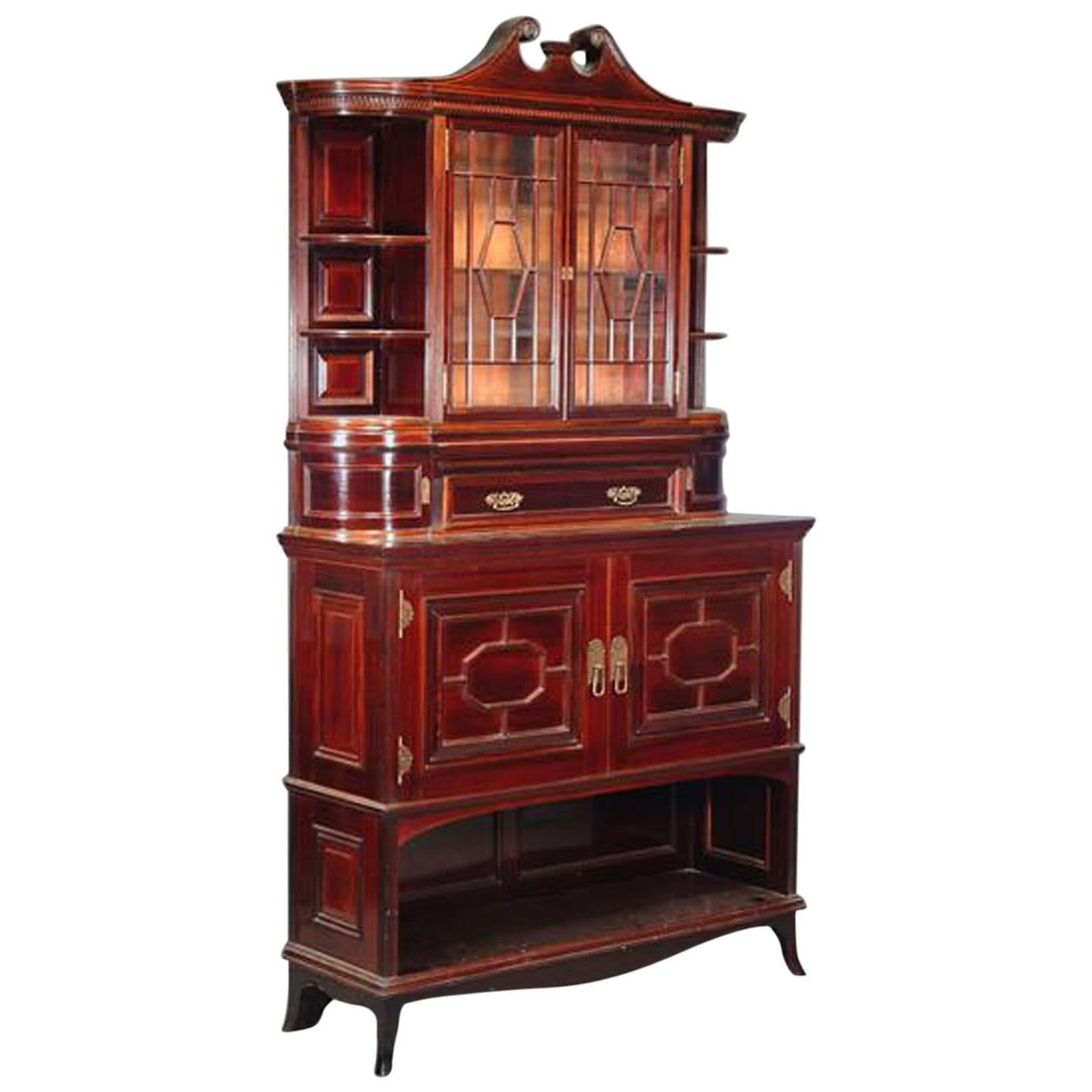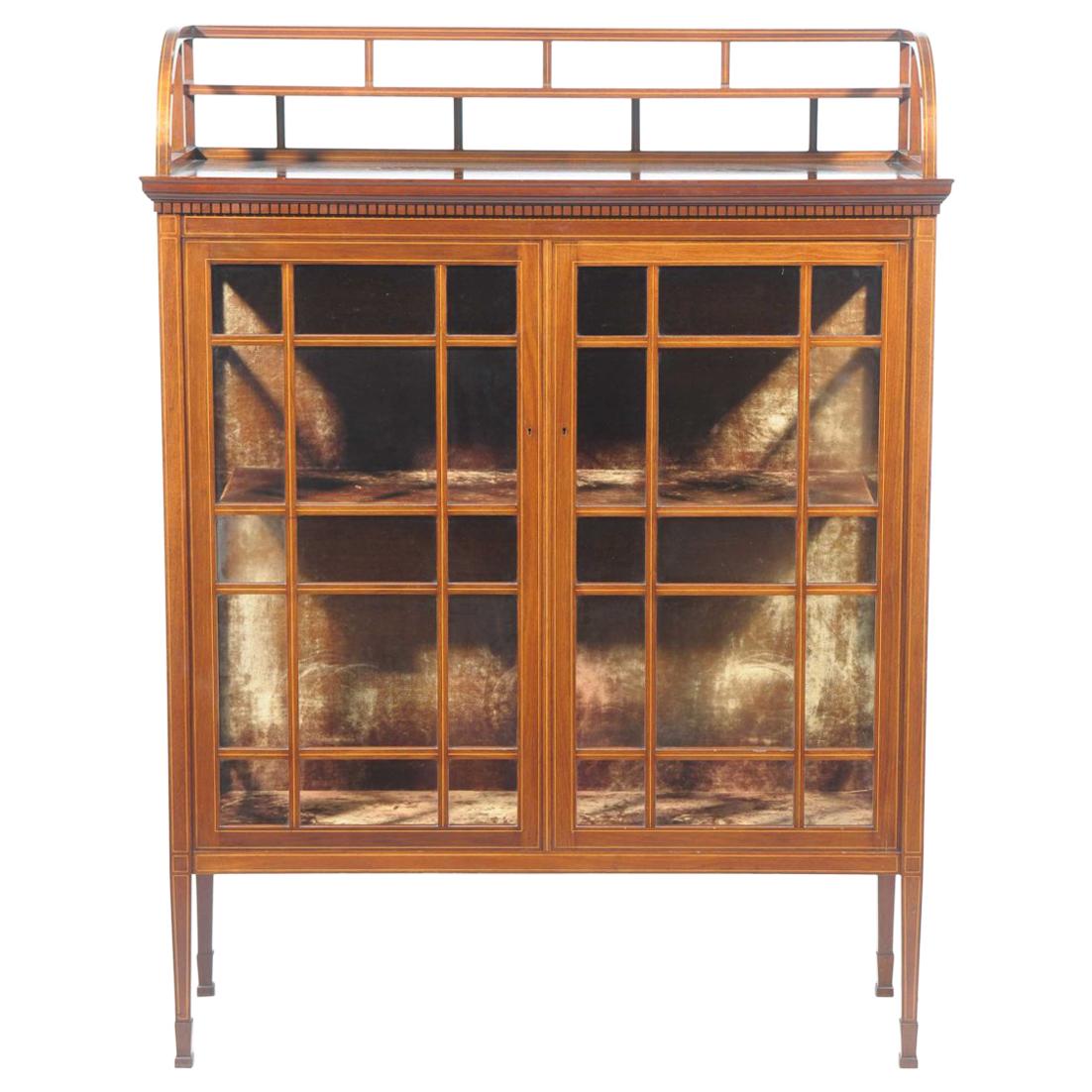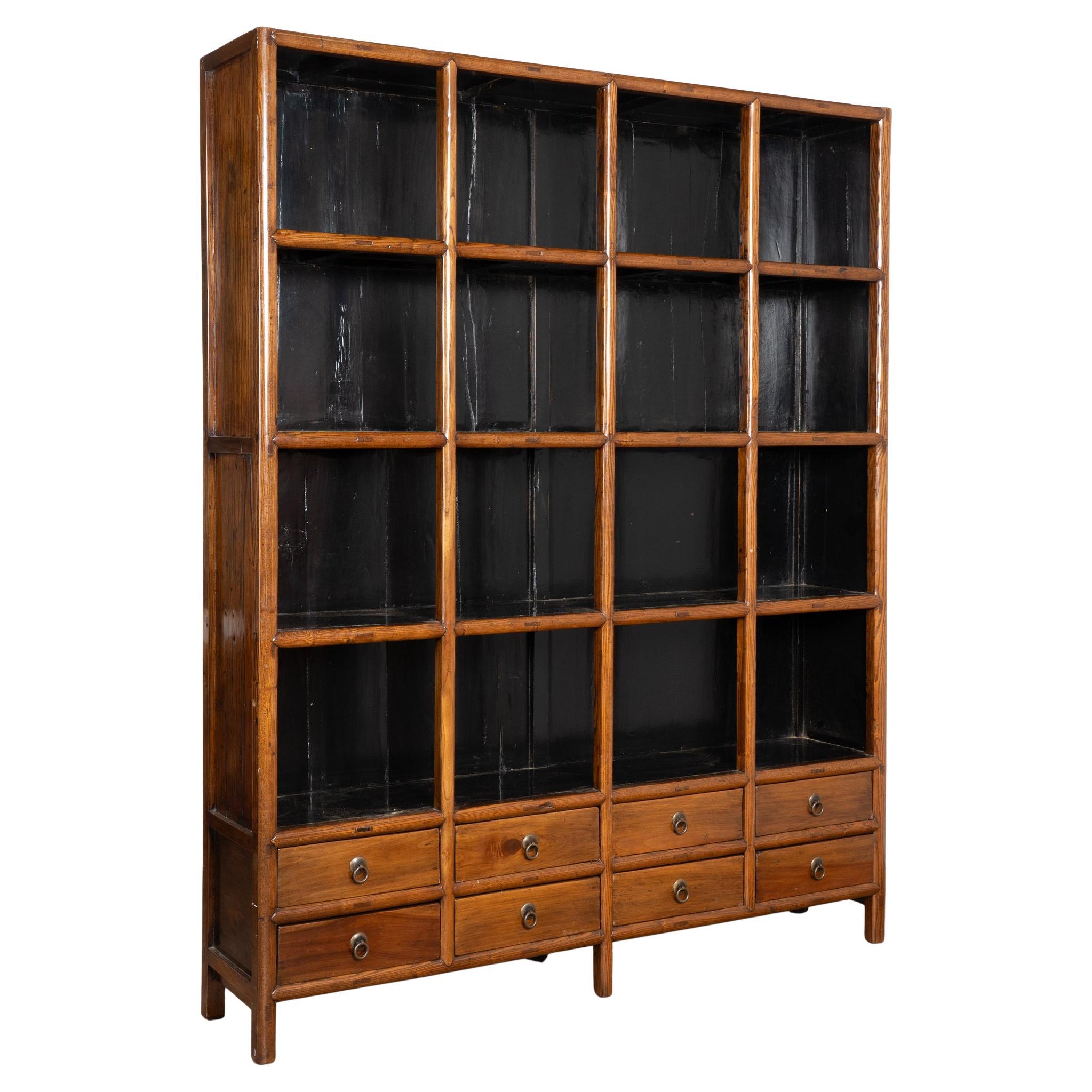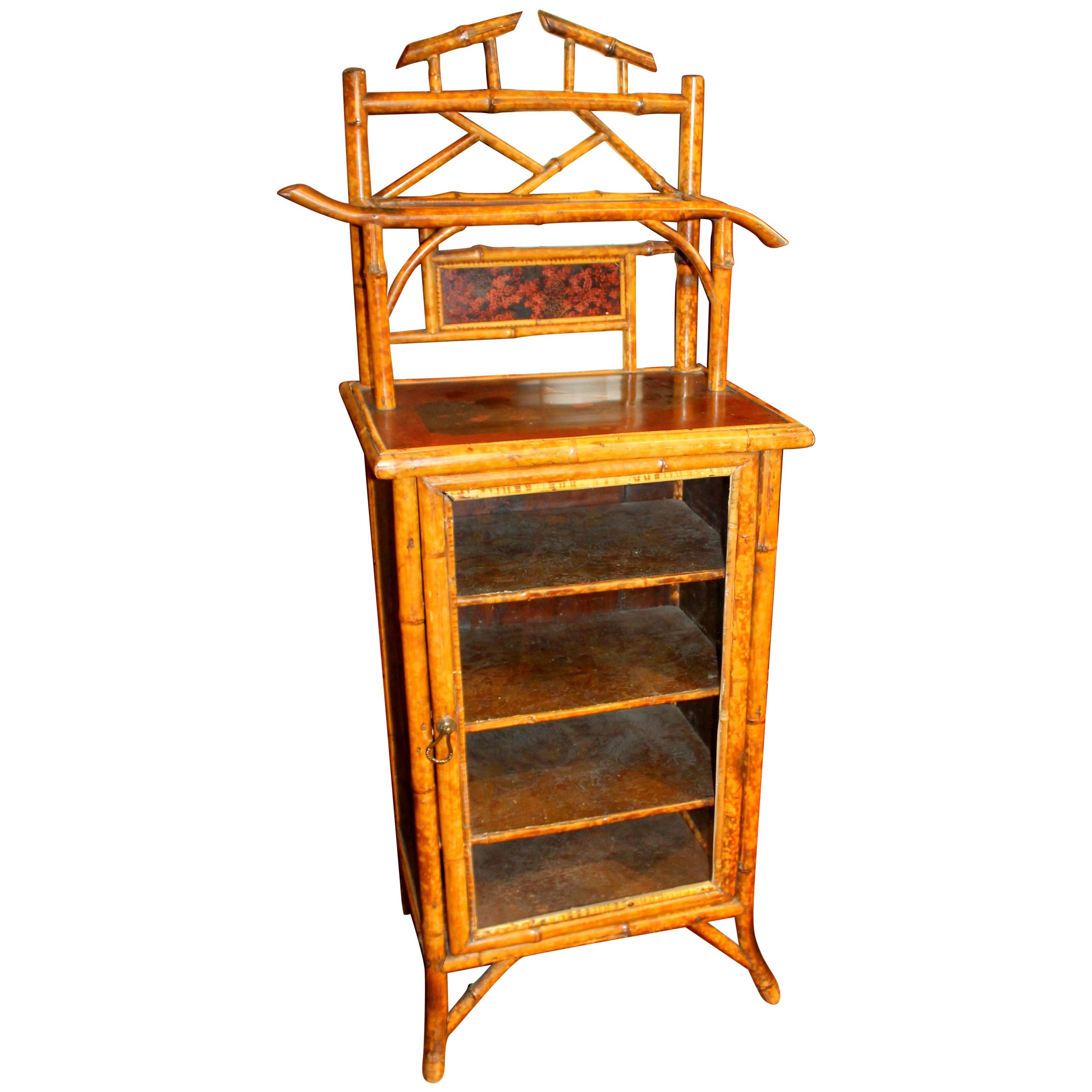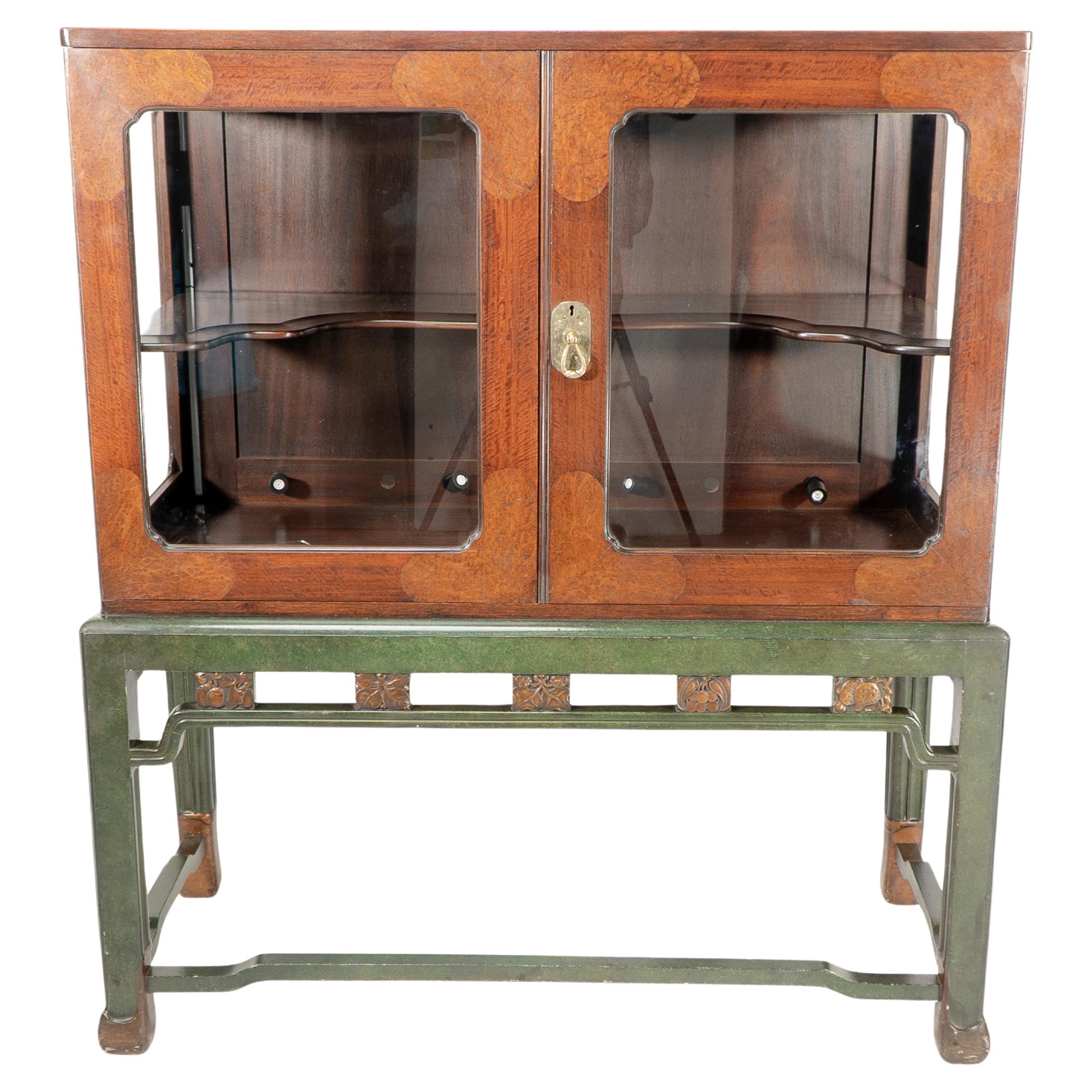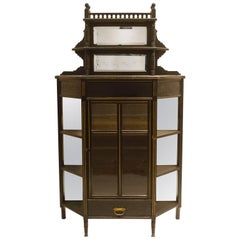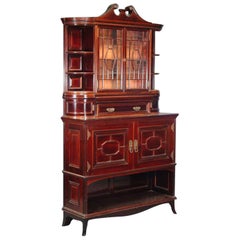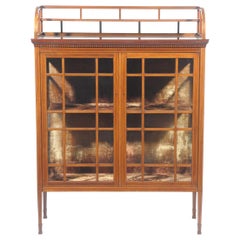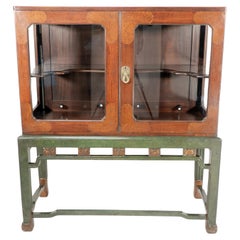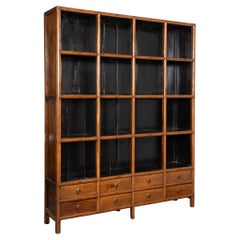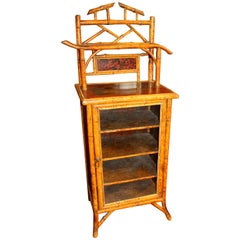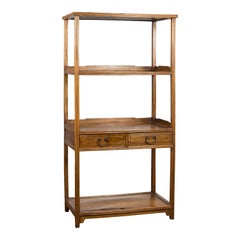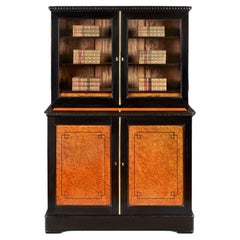Items Similar to E W Godwin An Important Anglo-Japanese Bookcase Painted by Henry Stacy Marks
Want more images or videos?
Request additional images or videos from the seller
1 of 17
E W Godwin An Important Anglo-Japanese Bookcase Painted by Henry Stacy Marks
$110,349.45
£80,000
€94,248.81
CA$151,575.68
A$168,543.45
CHF 88,235.53
MX$2,058,789.75
NOK 1,108,766.48
SEK 1,043,017.08
DKK 703,560.86
About the Item
Edward William Godwin (1833-1886) for William Watt, a rare and important Anglo-Japanese walnut bookcase, circa 1871. With brass handles and shield style escutcheon, the lower cupboard with two sliding doors inset with painted panels attributed to Henry Stacy Marks.
See Soros, Susan Weber 'The Secular Furniture of E.W. Godwin' Yale 1999, p. 201, plate 321 for an illustration of a related example.
See also Christie's sale 'Important 20th century design' 26th May 2005, lot 47.
In 1949 Dudley Harbron photographed and recorded a bookcase that he concluded had been made for Dr. George Bird, a friend of Ellen Terry (See Godwin's ledger for 17th September 1871) and the father of Elfrida Bird who married Luke Ionides. That bookcase, now cut-down, together with another corresponding example, was then in the possession of Mrs Lewis Clarke, having been inherited from her grandfather, Alexander Ionides son of Elfrida and Luke. A third bookcase was known to have been in the possession of Mrs Alecco Ionides at about the same time (Soros p.201). Despite Harbron's research and evident interest in these bookcases, they were poorly maintained by their owners, and two were thought to be destroyed (Soros, p.201), whilst one of the examples had its shelved superstructure removed and discarded. Susan Soros notes that this cut-down version is in 'stained oak' but one can clearly see in her illustration (Soros, p.201), it is not made from polished oak at all but exactly like the present example made from walnut. Both being made from walnut and both having identical measurements to their bases gives even more weight towards the most likely event that only one of the three cabinets was completely destroyed and the cut-down version is quite likely to be one of the two thought to have been destroyed, which it partially was. The present example is the only known example in existence to have emerged intact and is therefore unique! The painted panels to the cut-down 'Bird-Ionidies' example depict scenes from Greek antiquity. On the present version there is a painted panel to one side probably by Henry Stacey Marks, the attribution made by Christie's Art department and Susan Weber Soros, and is in good condition. The pencil and watercolour cartoon to the other panel, although quite faded and somewhat distressed, has the feel of Edward Burne Jones's work and interestingly the panels were originally believed to be executed by Burne Jones although Harbron in 1949 maintains the panels were painted by Charles Glidden who died young at 20 years of age. This panel has been attributed to Henry Stacey Marks by Christie's art department. Henry Stacey Marks is well documented to have painted for Godwin, to whom the panel of the present lot is attributed and which is also in the greek style. The figures in the painted panel are of two men helping an injured man and possibly may have been in combat with the knight in the other panel, and again their attire does also point to Greek Mythology. The opposite panel is quite different and depicts a prince or knight about to kiss a maiden or a princess, she is looking into his eyes, reaching out and touching his arm about to kiss. There is a sword lying at his feet and his own sword is held to his waist or in his belt with the blade in view and the point to the earth, it looks as if there may be the tail of what could be a dragon adjacent to the sword and possibly a person that may have been slain lying by the maiden. In the right-hand corner there is a castle with banner flying and a crescent moon beside it. The Ionidies family were probably the biggest and most generous patrons of the arts, building one of the most important and impressive collections in the late Victorian Period, and refined collectors of art from the Aesthetic Movement, Ionides's POOL of artists to choose from was thoroughly connected through his High Society circle of friends which included Edward Calvert and George Frederick Watts, who painted their family portrait when Luke was a child, James McNeill Whistler, Edward Poynter, George Du Maurier, Thomas Armstrong, Dante Gabriel Rossetti and Edward Burne Jones. William Morris, Phillip Webb, Walter Crane and Thomas Jeckyll, all part of his circle of friends, were commissioned to re-decorate 1 Holland Park, their family home, which is all well documented. Henry Stacey Marks (1829-1898) was a painter, watercolorist and illustrator, who worked as a muralist and decorator for Burges, Godwin and Waterhouse. In 1869 Marks was commissioned by Godwin to execute an allegorical frieze to the dining room of Dromore Castle, but due to the incurable dampness of Dromore's enormously thick walls it never came to fruition. An important point is that on the present example there are two brass lock plates to the right-hand side, one in the middle of the central upright that runs through the middle of the bookcase side and another one in the middle of the same central upright but located in the middle of the lower cupboard, these plates (one now missing) were used for joining two bookcases together and would have utilised a brass thumbscrew (also now missing). The sides of this bookcase and the 'Bird-Ionides' bookcase are completely flat from top to bottom which allows for them to butt up perfectly, a design detail that until now was unknown, and which gives even further strength to this present version being one of the very original pair. The present bookcase has a depositary label to the back of Famine's, Colchester and handwritten 'G.M.LAWRENCE', Mrs G M Lawrence, who was the last owner of it. She was one of the last relatives of the Lawrence's who passed away in her 90s in 2004. The Lawrence family owned a very successful lemonade and ginger ale company with factories and warehouses in Beccles, Bungay and Halesworth, Suffolk. It was removed from Mrs G M Lawrence's house by Durrants auctioneers, one of the original houses that was built by the Lawrences in Station Rd, Beccles. At some point in its life it made the journey down from London to Colchester and spent some time there, although exactly where is unknown. It seems its next move would have been from Colchester to Beccles. The measurements of the cut-down version are identical to the lower half of this version, in Soros, Susan Weber - The Secular Furniture of E.W. Godwin the cut-down version measures 35 1/4' high, which is the very same height to the open area of this present version, and again the depth and width of both of these examples are identical 19' deep, 39' wide. The present version measures 89 1/2' high.
- Creator:Edward William Godwin (Designer)
- Dimensions:Height: 85.5 in (217.17 cm)Width: 39 in (99.06 cm)Depth: 19.5 in (49.53 cm)
- Style:Anglo-Japanese (Of the Period)
- Materials and Techniques:
- Place of Origin:
- Period:
- Date of Manufacture:1871
- Condition:Wear consistent with age and use.
- Seller Location:London, GB
- Reference Number:1stDibs: LU224335803673
About the Seller
5.0
Platinum Seller
Premium sellers with a 4.7+ rating and 24-hour response times
Established in 1989
1stDibs seller since 2016
296 sales on 1stDibs
Typical response time: <1 hour
- ShippingRetrieving quote...Shipping from: London, United Kingdom
- Return Policy
Authenticity Guarantee
In the unlikely event there’s an issue with an item’s authenticity, contact us within 1 year for a full refund. DetailsMoney-Back Guarantee
If your item is not as described, is damaged in transit, or does not arrive, contact us within 7 days for a full refund. Details24-Hour Cancellation
You have a 24-hour grace period in which to reconsider your purchase, with no questions asked.Vetted Professional Sellers
Our world-class sellers must adhere to strict standards for service and quality, maintaining the integrity of our listings.Price-Match Guarantee
If you find that a seller listed the same item for a lower price elsewhere, we’ll match it.Trusted Global Delivery
Our best-in-class carrier network provides specialized shipping options worldwide, including custom delivery.More From This Seller
View AllE W Godwin, William Watt, an Important Anglo-Japanese Ebonised Display Cabinet
By Edward William Godwin, William Watt
Located in London, GB
Edward William Godwin made by William Watt, with applied enamel label.
An Important Anglo-Japanese ebonised display cabinet with an upper and...
Category
Antique 1870s English Anglo-Japanese Cabinets
Materials
Walnut
19th C. English Rosewood China Cabinet, E.W. Godwin for Collinson & Lock, London
By Collinson & Lock, Edward William Godwin
Located in London, GB
Rosewood China Cabinet, circa 1878, designed by Edward William Godwin (1833-1886) for Collinson & Lock, London. From the Collection of Eaton Hall, Cheshire, England. The Eaton Hall cabinet, circa 1878, in rosewood, the scroll-carved broken arched Queen Anne pediment above a dentil and moulded frieze, with a pair of astragal glazed doors flanked by shelves beneath fielded panels, above a central drawer and semi-circular cupboards, the moulded top above a pair of panelled doors with an open panelled section beneath, on shaped splayed feet, japanesque engraved brass handles, hinges and lockplates, stamped 'Collinson and Lock, London 7480', the handles, hinges and lockplates all stamped 'Elsleys, Gt Portland St, London'.
Provenance: Eaton Hall, Cheshire. A previous owner purchased this lot from a sale of the contents at Sweetenhams of Chester, 20th and 21st May 1959, where it states:- '283. Rosewood display cabinet, the upper portion enclosed with astragal glazed doors with side shelves, the lower portion enclosed with two panelled doors. This was the last mention of the Rosewood cabinet before it was sold.
This piece has many features, which firmly show Godwin's hand at work, i.e. Queen Anne broken pediment, (Soros, Susan Weber 'The Secular Furniture of E.W. Godwin', Butterfly cabinet, p. 227; and a Queen Anne cabinet p. 269 and an 'over door', p. 251), the dentil moulding to the top is identical to the Butterfly cabinet, the astragal glazed doors and panelled lower doors identical to a design for a table for Grey Towers (Susan Soros, 'Secular Furniture', p. 157 and similar detail to the doors on two cabinets on pp. 222-223). The semi-circular central side doors and semi-circular open shelves above are identical to a dressing table and a sketch for a dresser (Susan Soros, 'Secular Furniture', p. 211), a design for a mantelpiece (Susan Soros, 'Secular Furniture', p. 248) and a design for a buffet (Susan Soros, 'Secular Furniture', p. 265). The integrated design of solids and voids in many of his cabinet designs and the framed back panels to each individual shelf and framed panels to each side is typical of his work. The splayed front feet are identical to the Four Seasons cabinet (Susan Soros, 'Secular Furniture', p. 217). The elongated handles with japanesque engraved backplates simulate Japanese woven rush work (Susan Soros, 'E.W. Godwin Aesthetic Movement, Architect and Designer', p. 303, fig. 11-10 and Susan Soros, 'Secular Furniture', p. 268) a detail he used in many combinations. 'Sheraton and Queen Anne in Japan at Eaton Hall' only Godwin could have designed this exceptional work of art. Possibly part of a larger commission, the Eaton Hall archivist also found a Collinson and Lock billiard table in the inventory at Eaton Hall.
Godwin is known to have designed billiard tables for Collinson and Lock, a design appears in his sketchbook on the 6th of October 1873, carved in the Jacobean style with circular decorations of white storks in relief interspersed with square panels.
A corresponding entry on the 7th of October 1873 it shows that he designed it for the McLaren house, a large commission that Godwin did at Adison Rd, Kensington. The third Marquis of Westminster, who later became the 2nd Duke of Westminster, commissioned Sir Alfred Waterhouse to substantially remodel and rebuild Eaton Hall. The work began in 1869 and reached its completion in 1883. The large drawing room can be seen in a photograph taken, circa 1887, pl. 199 in Cooper, Jeremy. Victorian and Edwardian Furniture and Interiors, in which Cooper mentions that the Duke had spent 600,000 pounds on the decoration alone and that Heaton, Butler and Bayne carried out the work.
In 1885, an inventory of the contents of Eaton Hall was carried out, and it is precisely at this point in time that the cabinet receives its first mention. Having occupied a place in the Ormand Sitting Room, 72 on the ground floor of the North Wing of the Waterhouse Hall, the cabinet was described as, 'A Rosewood china cabinet with cupboards beneath and glass fronts at the top, 50ins'. The cabinet is then mentioned again in a 1917 inventory in the Angel Bedroom.
The cabinet made its next appearance in 1931 in the 'Declaration of Trusts', which was a valuation of the contents of Eaton Hall, appearing as T86/27 in the Stewards Offices with a similar description, and then finally in the 1959 sale catalogue mentioned above.
Sotheby's and various other local auctioneers held many sales of the various contents of Eaton Hall from 1955 through to 1961 until the Hall was demolished in 1961.
This description was compiled with the generous help and assistance of the Grosvenor Estate's Archive Department, Eaton Hall, Cheshire.
Collinson and Lock of London...
Category
Antique Late 19th Century English Anglo-Japanese Cabinets
Materials
Rosewood
E W Godwin, Collinson & Lock, an Anglo Japanese Mahogany and Satinwood Cabinet
By Collinson & Lock, Edward William Godwin
Located in London, GB
Edward William Godwin. Made by Collinson & Lock.
A fine quality Anglo Japanese mahogany and astragal glazed cabinet with satinwood line inlay.
...
Category
Antique 1870s English Anglo-Japanese Cabinets
Materials
Mahogany, Satinwood
Sir Robert Lorimer attr. Whytock & Reid Edinburgh Anglo-Chinese display cabinet
By Sir Robert Lorimer, Whytock & Reid
Located in London, GB
Sir Robert Lorimer attributed, for Whytock and Reid Edinburgh. An Anglo-Chinese mahogany and burr walnut display cabinet with green painted and gilded wood.Literature: Savage, Peter,...
Category
Vintage 1920s English Anglo-Japanese Vitrines
Materials
Mahogany
Rare Set of Anglo-Japanese Ebonised Hanging Book Shelves by E W Godwin
By Edward William Godwin
Located in London, GB
Edward William Godwin (1833-1886). Made by William Watt or Edwards and Roberts
A rare set of Anglo-Japanese ebonized hanging bookshelves with an extending lower shelf and a two-door ...
Category
Antique Late 19th Century Great Britain (UK) Anglo-Japanese Shelves
Materials
Walnut
Lambs of Manchester. An Anglo-Japanese secretaire bookcase with lacquered panel
By Lamb of Manchester
Located in London, GB
Lambs of Manchester. An Anglo-Japanese secretaire bookcase with a Japanese lacquered panel to the drop down writing area, an array of drawers with a cabinet to the top with bevelled ...
Category
Antique 1880s Anglo-Japanese Bookcases
Materials
Walnut
You May Also Like
20th Century Chinese Elmwood Bookcase Open Display Cabinet
Located in Round Top, TX
Large elmwood display cabinet or bookcase with open shelving and eight lower drawers.
Interior shelf dimensions: 67.5"w x 13" deep to front edge x15.5"h. Black background.
Restored, ...
Category
Early 20th Century Chinese Chinese Export Bookcases
Materials
Elm, Paint
Antique English "Anglo-Japan" Victorian Hand Painted Bamboo Cupboard/ Étagère
Located in CHARLESTON, SC
Fine quality antique English "Anglo-Japan" Victorian hand painted lacquer and bamboo single door cupboard/ étagère with embossed panel sides; "tortoise shell" shaded bamboo; fabulous...
Category
Antique Late 19th Century English Victorian Corner Cupboards
Materials
Bamboo, Lacquer
Late Qing Dynasty Period Bookshelf with Classic Design and Drawers
Located in Yonkers, NY
A Chinese late Qing Dynasty period bookcase from the early 20th century with classic design, four shelves and two drawers. Created in China during the late Qing Dynasty period in the early years of the 20th century, this wooden bookcase features a classic design with two drawers. The elegant linear silhouette presents four shelves interrupted in the center by two drawers. These drawers are adorned with slightly raised cartouches and are fitted with brass c-scroll handles on floral backplates. Each of the two middle shelves...
Category
Early 20th Century Chinese Qing Bookcases
Materials
Brass
A Rare Mid 19th Century Anglo Chinese Amboyna Bookcase
Located in London, GB
Anglo Chinese, circa 1860
A rare mid nineteenth century Anglo Chinese campaign amboyna and ebonised bookcase with glazed upper section, the doors revealing three shelves and two dra...
Category
Antique Mid-19th Century Chinese Campaign Bookcases
Materials
Amboyna
19th Century Antique Chinoiserie Pier Display Cabinet Edwards & Roberts Mahogany
Located in Wisbech, Cambridgeshire
Introducing a distinguished 19th Century Antique Mahogany Pier Display Cabinet crafted by the esteemed maker Edwards & Roberts. This exceptional piece showcases intricate Chinoiserie...
Category
Antique 19th Century Cabinets
Materials
Mahogany
$2,891 Sale Price
30% Off
Anglo-Chinese Amboyna and Secretaire Bookcase
Located in Lymington, Hampshire
A fine Amboyna Anglo Chinese secretaire bookcase from the first half of the 19th century.
The fitted secretaire raised above three draws all with flush ...
Category
Antique Mid-19th Century Chinese Bookcases
Materials
Amboyna
More Ways To Browse
Antique Brass Marks
Japanese Antique Marks
Antique Hand Painted Photographs
Japanese Sword Furniture
Antique Record Cabinet
Hand Painted Banner
William Morris Arts And Crafts
Japanese Painted Cabinet
19th Century Cartoons
90s Cabinet
William Shields
Japanese Door Panels
Painted Dutch Cabinet
William Morris Antique Furniture
Sword And Shield
Japanese Door Handle
Japanese Painted Door
Antique Japanese Sword
